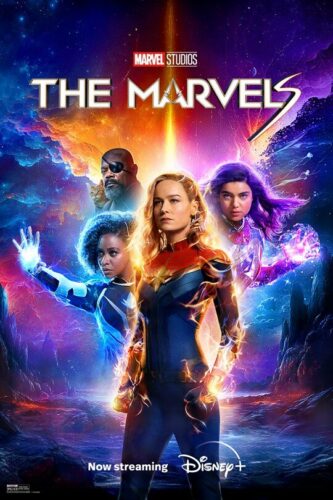 Three different projects come together into one.
Three different projects come together into one.
What They Say:
Carol Danvers, aka Captain Marvel, has reclaimed her identity from the tyrannical Kree and taken revenge on the Supreme Intelligence. However, unintended consequences see her shouldering the burden of a destabilized universe. When her duties send her to an anomalous wormhole linked to a Kree revolutionary, her powers become entangled with two other superheroes to form the Marvels.
The Review:
Content: (please note that content portions of a review may contain spoilers)
As I am one of those people who have not returned to the theatrical experience since the pandemic, I was finally able to see The Marvels as it hit Disney+ streaming. I don’t mind being behind on things like this because the deluge of online opinion during the theatrical release of properties like this are simply too problematic for a lot of reasons. Getting past the hype and vitriol works best for me and I get to disconnect from a lot of that – though I know full well that it’s still percolating in the back of my mind. The Marvels is a film that definitely has issues but you can see where the reason for it was likely coming from a higher point of view of how the project should come together while also having to deal with bringing together characters from different areas; Carol Danvers from the previous films, Kamala Kahn from her Ms Marvel series, and Monica Rambeau from WandaVision.
First, let’s just make it clear what the basis of the film is and why it’s truly the most problematic because it’s not set up at all and is a gotcha later in the film that simply does not work. After the events of Captain Marvel, Carol went back to Hala and destroyed the Supreme Intelligence that ruined her life and manipulated her until her memories broke free from that film. What Carol did basically caused a massive civil war among the Kree with various factions and it led to a lot of destruction over the past thirty years. They’ve now coalesced around Dar-Benn, a woman who was a Kree soldier at the time of Carol’s action, and she along with many others have witnessed the collapse of the Kree Empire and specifically Hala where it’s now without much oxygen and little war. And its sun has been turned into a red dwarf.
While we see some of this early on, the reason why is hidden until much later to the detriment of the film and more specifically the villain in Dar-Benn. Not that what she’s doing is good or understandable in any way, but she’s executing a revenge tour among various worlds while stealing their water and air to bring it back to her world. She’s accomplishing that thanks to finding a quantum band – half of a pair of them – and using that to create new chaotic jump points from worlds back to Hala where they essentially suck up those worlds to Hala. It’s Spaceballs and she’s set to suck. Again, don’t think too clearly about the logic, physics, and so forth of this. I can understand why few worlds would want to help Hala after being part of their Empire, but at the same time, that they lost so much control so quickly is telling in all the factionalism and just how critical the Supreme Intelligence was to maintaining order.
Anyway, so that has Dar-Benn going to various worlds, sucking up resources, killing people, and all that jazz because those worlds are important to Carol who they have rebranded as the Annihilator for what she did. What sets the problems in the present is that Dar-Benn’s finding of the quantum band and activating it when dealing with Carol has activated a kind of quantum entanglement that brings a connection to Kamala and Monica as well. And that entanglement has them swapping places when they use their powers at the same time. This is utterly chaotic and it doesn’t always work but when it does it’s an absolute delight of choreography and absurdity – particularly thanks to the secret weapon that is Iman Vellani. So we get Carol brought from a far-off world to Kamala’s bedroom in Jersey City where she’s thrust into meeting Kamala’s family – and dealing with some Kree warriors who got caught up in it. Monica is doing some scientific work in orbit on SABER and she’s drawn into it as well. So all three start zapping between the three places and issues going on there while being utterly confused. Thankfully, we do get it explained to the regular folks around them (and Nick Fury) and it helps to move things forward as they basically have to deal with Dar-Benn and stop her from destroying more worlds.
The film is one that is constantly moving and that is to its advantage because you don’t want to think too hard on Hala and Dar-Benn’s story since both are underdeveloped. The main attraction are the three leads together and trying to figure out exactly what Dar-Benn is up to and learning about each other so that they can work effectively. Frankly, it just works for me and I like that it leans into some elements of what Thor: Ragnarok was without going too far into it, such as the world of Aladan and the way it works. It was the right kind of second-act break into levity that it needed and to let the personality of the core trio shine through. So when things do get darker and more bleak as the final fight arrives, you’ve got some good stuff built into it and, for me, I was able to push back all the problematic opening act elements with the setup of the film.
We do get a b-plot of sorts involving Fury on SABER as it becomes important in the third act but this is where things tend to be lighter throughout the film. He’s got Kamala’s parents brought up for Earth after meeting them and I was so glad to get at least them and her brother involved in the film because family is Kamala’s thing. SABER gets a light touch overall but it has some fun elements to it and lets the film play with Goose a lot. The Flerkin was a popular part of Captain Marvel and while it was obvious what was going on with it in the third act very early, they found an amusing if absurd thing to do with the creature to provide some additional comedy. I’m not sure the film found a good balance between drama, action, and comedy throughout and the third act certainly tilted in some weird ways. But that’s the thing; the whole film felt like it needed a very different edit and more downtime footage mixed in to humanize it so that things were spread out a bit more with the more outlandish elements like this.
In Summary:
I completely get a segment of the hate the film gets because it has structural issues that feel more like corporate-mandated problems than directorial problems. It’s like it was written around trying to deal with that and still tell the story it wanted to tell. It could have been done without a lot of the flashback stuff and just been implied or a line or two and then moved forward. Either a viewer will know what’s happening from the past or they won’t know and will have to make a choice to go watch the other part eventually or not. The history doesn’t have to be front and center each time and it can just exist without being shown. That said, there are some delightful moments of it and how it ends up feeding into an absolutely wonderful post-credits scene with Monica that I knew about but didn’t really fathom until I saw it.
Either way, I had a lot of fun with this movie, the performances, and the overall design of it. There are things that aren’t right or good but the good stuff outweighs it in the long run and I’m looking forward to revisiting it and seeing where things spin out from here since there’s a lot to like.
Grade: B
Streamed By: Disney+




